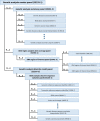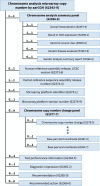Supporting interoperability of genetic data with LOINC
- PMID: 25656513
- PMCID: PMC5566197
- DOI: 10.1093/jamia/ocu012
Supporting interoperability of genetic data with LOINC
Abstract
Electronic reporting of genetic testing results is increasing, but they are often represented in diverse formats and naming conventions. Logical Observation Identifiers Names and Codes (LOINC) is a vocabulary standard that provides universal identifiers for laboratory tests and clinical observations. In genetics, LOINC provides codes to improve interoperability in the midst of reporting style transition, including codes for cytogenetic or mutation analysis tests, specific chromosomal alteration or mutation testing, and fully structured discrete genetic test reporting. LOINC terms follow the recommendations and nomenclature of other standards such as the Human Genome Organization Gene Nomenclature Committee's terminology for gene names. In addition to the narrative text they report now, we recommend that laboratories always report as discrete variables chromosome analysis results, genetic variation(s) found, and genetic variation(s) tested for. By adopting and implementing data standards like LOINC, information systems can help care providers and researchers unlock the potential of genetic information for delivering more personalized care.
Keywords: Clinical laboratory information systems; Genetics; LOINC; Medical records systems; Vocabulary; controlled.
© The Author 2015. Published by Oxford University Press on behalf of the American Medical Informatics Association. All rights reserved. For Permissions, please email: journals.permissions@oup.com.
Figures
Similar articles
-
Implementing LOINC: Current Status and Ongoing Work at the Hannover Medical School.Stud Health Technol Inform. 2019;258:247-248. Stud Health Technol Inform. 2019. PMID: 30942760
-
Implementing LOINC - Current Status and Ongoing Work at a Medical University.Stud Health Technol Inform. 2019 Sep 3;267:59-65. doi: 10.3233/SHTI190806. Stud Health Technol Inform. 2019. PMID: 31483255
-
Encoding laboratory testing data: case studies of the national implementation of HHS requirements and related standards in five laboratories.J Am Med Inform Assoc. 2022 Jul 12;29(8):1372-1380. doi: 10.1093/jamia/ocac072. J Am Med Inform Assoc. 2022. PMID: 35639494 Free PMC article.
-
Logical Observation Identifiers Names and Codes for Laboratorians.Arch Pathol Lab Med. 2020 Feb;144(2):229-239. doi: 10.5858/arpa.2018-0477-RA. Epub 2019 Jun 20. Arch Pathol Lab Med. 2020. PMID: 31219342 Review.
-
In support of interoperability: A laboratory perspective.Int J Lab Hematol. 2023 Aug;45(4):436-441. doi: 10.1111/ijlh.14113. Epub 2023 Jun 20. Int J Lab Hematol. 2023. PMID: 37337695 Review.
Cited by
-
Efficient Results in Semantic Interoperability for Health Care. Findings from the Section on Knowledge Representation and Management.Yearb Med Inform. 2016 Nov 10;(1):184-187. doi: 10.15265/IY-2016-051. Yearb Med Inform. 2016. PMID: 27830249 Free PMC article.
-
Pharmacogenomic testing and prescribing patterns for patients with cancer in a large national precision medicine cohort.J Med Genet. 2023 Jan;60(1):81-83. doi: 10.1136/jmedgenet-2021-108112. Epub 2021 Dec 6. J Med Genet. 2023. PMID: 34872990 Free PMC article.
-
Standardizing terms for clinical pharmacogenetic test results: consensus terms from the Clinical Pharmacogenetics Implementation Consortium (CPIC).Genet Med. 2017 Feb;19(2):215-223. doi: 10.1038/gim.2016.87. Epub 2016 Jul 21. Genet Med. 2017. PMID: 27441996 Free PMC article.
-
The potential adoption benefits and challenges of LOINC codes in a laboratory department: a case study.Health Inf Sci Syst. 2017 Oct 11;5(1):6. doi: 10.1007/s13755-017-0027-8. eCollection 2017 Dec. Health Inf Sci Syst. 2017. PMID: 29067166 Free PMC article.
-
Creation of a structured molecular genomics report for Germany as a local adaption of HL7's Genomic Reporting Implementation Guide.J Am Med Inform Assoc. 2023 May 19;30(6):1179-1189. doi: 10.1093/jamia/ocad061. J Am Med Inform Assoc. 2023. PMID: 37080557 Free PMC article.
References
-
- Green ED, Guyer MS. Charting a course for genomic medicine from base pairs to bedside. Nature. 2011;470(7333):204–213. doi:10.1038/nature09764. - PubMed
-
- Ullman-Cullere MH, Mathew JP. Emerging landscape of genomics in the Electronic Health Record for personalized medicine. Hum Mutat. 2011;32(5):512–516. doi:10.1002/humu.21456. - PubMed
-
- US Department of Health and Human Services, Office of the National Coordinator for Health Information Technology. Clinical lab-test results. http://www.healthit.gov/providers-professionals/achieve-meaningful-use/c.... Accessed September 1, 2014.
Publication types
MeSH terms
Grants and funding
LinkOut - more resources
Full Text Sources
Other Literature Sources
Medical



